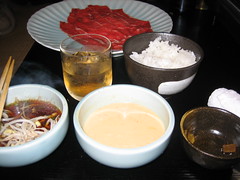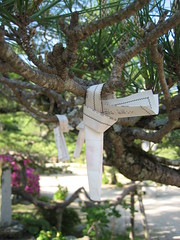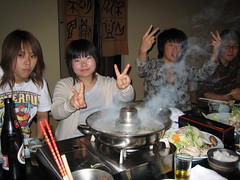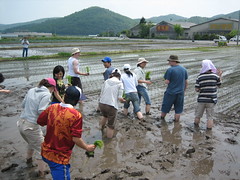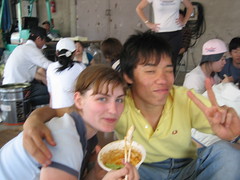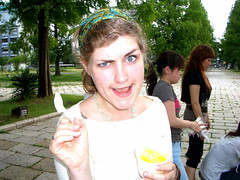And to prove it here's what's been keeping me up nights . . . .
It could have been better but it's done . . . I couldn't transfer the refering but trust me there was a whole load of it!
Critically examine the various reasons that America had for dropping two Atom bombs. Why were Hiroshima and Nagasaki chosen as targets ?The first use of the Atom bomb against humans is a moment in history that stands out vividly for many people. As time passes and the memories may fade, there still seems to be a significant amount of interest in the details of decision-making surrounding the use of the bombs.
When considering why the Atom bombs were dropped, it is important to take into account the acceptance of ‘terror bombing’ as standard warfare tactics during WWII, the contemporary understanding (or lack thereof) of the effects of the bomb, increasing desperation in all countries to end the war and high casualty toll, and the role of racial vilification. There are also theorists who suggest that post-war balance of power amongst the Allies influenced the decision to use the bombs and that there was considerable pressure on President Truman to justify the enormous expenditure of the project with tangible results.
When considering why Hiroshima and Nagasaki, in particular, were chosen as the targets, it can be informative to study the developing policies of the American government with regard to warfare in both Europe and the Pacific region. It is interesting to examine the reasoning that resulted in the bombing of two medium-sized cities rather than an exclusively military target. Whilst the choice of location was of crucial significance to the inhabitants of both cities, the decision-making process was a not a very complicated one, and was based on fairly simple criteria. Specifically in the case of Nagasaki, the ultimate decision on location came as result of bad weather over the other potential locations at the time of the bomb deployment, rather than any particularly outstanding feature of that city. Further consideration must be given to the context in which, and reasons why, America felt justified in making use of the bombs at all.
The beginning of the 20th century is notable for its occurrences of extreme and devastating violence. Both the First and Second World Wars feature great changes in the way in which wars were fought. Nye purports that WWI was a case of countries being too hardline and readily willing to go to war . However, as a result of the development of new forms of artillery and combat, the war far exceeded original expectations of its duration and magnitude. Nye then suggests that the depth of the atrocity of WWII was the result of early reluctance to counter Hitler’s rise with battle, born of the horror of the bloodshed and loss of WWI . Again, when WWII began new technology played an enormous role in the war. WWI had proven that ground combat was escalatingly futile and costly, whilst the increasing utilisation of aircraft during the war presented a new and seemingly highly effective option for WWII.
On April 26th 1937 German Luftwaffe attacked and devastated the civilian Basque town of Guernica in support of Franco’s fascist Nationalist party. This marked the first instance of incendiary bombing and strafing aimed specifically at civilians, rather than any military target, to occur on European soil, and was met by large public outcry and incredulity. This case of ‘terror bombing’, designed to demoralize and feed discontent among the civilian population of an enemy, and concurrently weaken its strength through reductions in population, industry and materials. In hindsight, this was very small scale and barely compares in figures to later incidents during WWII. Although the Germans initiated this type of warfare, it was to prove their downfall when the better equipped Allies eventually began to employ the same strategies as their compunction lessened for its adverse effect upon the civilian population.
At the onset of WWII much consideration was being given, by the Amercians, to the role of the airforce in battle as a result of its application during the end of WWI and such events as the aforementioned attack in Spain. America initially stated in policy that it was unprepared to participate in this ‘terror bombing’ employed by Nazi Germany. However, as the war dragged on and become bloodier and more desperate all sides began to utilize such modes of warfare. The bombing of cities by the Allies was designed to be precision bombing, targeting sites of military importance. However, conditions proved such that the reality of the situation was far more akin to the civilian aimed bombings strategically employed by the Germans. Consequently, during the 1940s politicians and the general public became inured to the bombing of civilian locations. The acceptable number of civilian causalities as ‘collateral damage’ gradually increased to the point where figures indicate they were considered legitimate targets. Ratios of the soldier to civilian deaths have been placed at 90% to 10% for WWI and by WWII this figure had been reversed to 23% to 77%.
The incendiary bombing of Japanese cities proved most effective because of the high flammability of traditional building materials, such as wood and rice paper, that were still used in the construction of most homes and small buildings. The high flammability of structures and the tendency of Japanese cities to be heavily built-up and densely populated resulted in catastrophic events such as the March 9th/10th fire-bombing of Tokyo in 1945 which is reported to have killed upwards of 100,000 people in one night . Given that such acts were already considered reasonable within the context of this war it is unsurprising that the Americans felt justified in using the Atom bombs at their disposal. Frank states that “Given the direction of aerial bombardment in Europe and Japan, the [Interim Committee] left no recorded qualms about describing the preferred targets as one of the “large urban areas of not less than three miles in diameter existing in the large populated areas”.” .
The droppings of the Atom bombs are considered to have been a serious leap up in the degree of destruction the Americans were prepared to wreak. However, the figures of fatalities are not that much higher than those already given for the fire-bombing of Tokyo. Documentary evidence from the time has shown that very few people involved in the decision-making process surrounding the bombs were capable of adequately realising the magnitude of the new weapons. During deliberations about the bombs it was “questioned whether the impact of the bomb really would be distinguishable from “any current air corps strike of current dimensions”.” . In many resources there are examples of largely differing projections as to the potential TNT equivalent that these uranium and plutonium bombs possessed. No-one really seemed to know just how dramatically different these new weapons were. In light of such limited understanding it seems reasonable that Americans should have proceeded as they did.
Attitudes displayed by the Japanese military forces and civilians convinced the Allied Forces that little short of full-scale decimation was likely to induce Japan to surrender. Belief in ultimate victory so long as the entire country made sacrifices for the war led to extreme behaviour that astounded American soldier. This is well exemplified in a statement made by Vice Admiral Onishi, a leading commander in the Kamikaze effort: “If we are prepared to sacrifice 20 million Japanese lives in a special attack [kamikaze] effort victory will be ours!” . There were also instances of civilian mass suicide rather than submit to capture by the Americans. This is considered the result of racial propaganda by the Japanese government to the effect that “the Americans would rape, torture and murder them, and that it was more honourable to take their own lives".
Also reinforcing the notion that the Japanese would not surrender easily was final official response to the Potsdam Declaration. There was initial bureaucratic bungling over dealing with the Declaration and though the cabinet wished to consider the proposal at greater length, they were forced to make public information which lead to media derision and rejection of the Declaration before the government could deliberate further. It was necessary to protect the government from diehard nationalists who would, more than likely, violently disagree with any decision to make a deal with the Allies. Therefore Prime Minister Suzuki announced “The government does not regard [the Potsdam Declaration] as a thing of any value; the government will just ignore [mokusatsu ] it. We will press forward resolutely to carry the war to a successful conclusion". Such statements were surely necessary to bolster the Japanese war effort but at a time when many high-ranking American military men considered that Japan was close to failure in the war, it may well have looked like a throwing down of the gauntlet; yet another instance of top-ranking officials’ apparent willingness to incite the country to national suicide rather than capitulation. It has also been suggested that had the Potsdam Declaration included intimation that the Japanese might be permitted to retain the Emperor upon surrender it may have been more favourably received.
In the face of such perseverance the Americans felt compelled to adopt an equally dogmatic stance. American and British leaders relentlessly continued to pursue “unconditional surrender” from Germany and Japan. Roosevelt initiated the use of the term “unconditional surrender” during talks in 1942 and President Truman, following Roosevelt’s death, continued to use the term in a propagandist style to galvanise the war effort . This term is also considered to have been a response to Hitler’s suggestions that Germany had lost WWI as a result of internal corruption rather than being defeated by the Allies ; Roosevelt was determined to see that there could be no doubt again. Nye suggests the policies Germany was forced to adopt after the WWI produced too much hardship with too little change to the existing infrastructure . Germany was financially crippled by the compensations it had to make but its government was not sufficiently altered to see that overwhelming nationalism couldn’t gain sway again . This determination was also applied to the Japanese, as American historian Herbert Bix explains
“[Unconditional surrender] never aimed at just smashing the fascist states. Its true objective was the military occupation and post-war reform – always the two together – of those states so that the philosophies of fascism and militarism could be uprooted and their societies democratized” .
It was with this ultimate goal that America increasingly employed all tactics within its power to bring about the downfall of Japan. As Colonel Harry F Cunningham said “We are making War and making it in the all-out fashion which saves American lives, shortens the agony which War is and seeks to bring about an enduring peace . . . For us, THERE ARE NO CIVILIANS IN JAPAN” .
This justification that dropping the bombs saved American lives is one that is regularly raised. The suggestion thousands would be saved by avoiding another land invasion of Japan was one of the strongest inducements to use the bombs. The earlier incursion into Okinawa had been such a bloodbath involving soldiers and civilians alike, which reportedly claimed 72,358 Americans alone. The causality figures from this battle were used to produce a projected figure for potential casualties that might be incurred by an attempt to take Kyushu. However, discrepancies appear between the number of American casualties forecast by government groups for consideration regarding a potential landing on Kyushu, and those figures later given to justify the use of the bombs. Figures of 500,000 to one million have been variously reported, but documentation seems to show that predictions based on the Okinawan and other Pacific War battles were closer to 40,000 fatalities, with a figure of just under 200,000 encompassing fatalities, the wounded and the missing. The exaggeration of these numbers is generally attributed to a desire to posthumously justify what many civilians in other parts of the world saw as a terrible crime against humanity.
In an American documentary Why did America drop the Atom bomb on Hiroshima ? one scholar also suggests that even had the predicted figures been much smaller than those given, Truman was likely to use the bombs anyway. In his lecture of 28/6/05 when discussing the topic, R.B. Parker said that ‘role morality’ plays a significant role in this kind of decision-making . In other words, that acting in the capacity of political leader, for the best interests of the country’s citizens one may be forced to make decisions that, on a personal or a Kantian scale of morality, might be impossible to make. Further, Parker asserted that any President who was found to have chosen to spare Japanese lives over American ones would have been impeached. Numerous sources also make references to Secretary of State and special representative for the President on the Interim Committee, James Byrnes, warning Truman, as Roosevelt had been warned , that any failure to produce results from such an expensive project would undoubtedly lead to questions in Congress. Additionally, the project was a legacy from Roosevelt’s term in office and Truman, it is suggested, from a feeling of political inferiority, respected and tried to complete all such projects .
There were two committees that deliberated over the potential bombings. The first, the Target Committee, was comprised of officers of General Leslie Groves and scientists. The second and more critical group consisted of some of the most high-ranking politicians, military officials and scientists involved in the construction of the bombs. This group, known as the Interim Committee, met with the sole aim of deciding where the bombs ought to be used. Interestingly, the question of whether or not to use the bombs was never officially discussed and the committee was simply concerned with identifying the optimal targets. As Frank states “The Interim Committee’s formal mandate did not include explicit review of the decision to use the bomb. By now the presumption that the bomb would be used as soon as available possessed a tremendous momentum of its own” .
When Truman came to the Presidency in America following the sudden death of the popular Roosevelt, many considered him incapable of the role. Indeed, despite being Vice President, Truman had gone completely uninformed of the Manhattan Project (codename for the Atom bomb development project) until sworn in as President. It is suggested that his personal concern for his political inexperience induced him to delegate decision-making to the most accomplished and able advisors that he could acquire. For this reason, it is stated, both Groves and seasoned Southern politician James Byrnes managed to control and direct discussion of the bomb through their powerful positions on the Interim Committee and personal standing with the President. The main considerations of the committee in relation to site location criteria were later concisely stated by Manhattan Project director Groves:
“I had set out as the governing factor that from the targets chosen should be places the bombing of which would most adversely affect the will of the Japanese people to continue the war. Beyond that, they should be military in nature, consisting of either important headquarters or troop concentrations, or centres of production of military equipment or supplies. To enable us to assess accurately the effects of the bomb, the targets should not have been previously damaged in air raids. It was also desirable that the first target be of such size that the damage would be confined within it, so that we could definitely determine the power of the bomb” .
Geographic location was of major concern to the Americans when considering where to drop the bombs at their disposal. The politicians and scientists wanted the opportunity to ‘battle test’ their new weapons whose powers were yet to be fully established. They were looking for a confined location that would concentrate the blast; a plain surrounded by hills and mountains seemed most suitable to their purposes. However, a greater difficulty lay in identifying targets relatively unscathed by prior bombing. Henry Stimson, chair of the Interim Committee, once remarked to Truman, that due to extensive conventional bombing they were in danger of not having any suitable targets left .
Hiroshima and Nagasaki ranked in the final group of potential targets because they each possessed all of the key requirements. They were of medium size and relatively untouched by prior air raids; contained manufacturing plants of significance to the war effort and housed military bases; in addition, both had traditionally thriving ports; and their geography was ideally suited to containment of the bomb. Furthermore, it has been thoroughly identified that the Americans no longer considered cities and large civilian populations to be inviolate. The ‘total warfare’ policy of all Japanese contributing to the war effort, and the situation of manufacturing plants and supplier buildings being built in and around residential areas further allowed the Americans to justify these city targets.
The state of communication within Japan is considered partly responsible for the fact that two bombs were dropped; that Nagasaki had to suffer the same terrible fate as Hiroshima. There were renewed calls from the Allied Forces for the “unconditional surrender” of Japan on the 6th and 7th of August in the wake of the bombing of Hiroshima. However, there was disbelief amongst Japanese officials over the reports that emerged from the city in the days following the bombing. The destruction of transportation and communication links by conventional Allied bombing meant that the passage of information about the incident was reasonably slow. Due to the lack of communication, the government was not aware of the full extent of the damage to the city and they did not respond to the Allies.
Regardless, the order to utilise the bombs had gone out as an individual order to proceed with their use according to prior plans, weather permitting. There never seems to have been any intention for review following the first bomb. This has also generally been attributed to underestimating the power of the bombs. As a result “Fat Man”, the nickname of the bomb dropped on Nagasaki, was loaded on August 9th when the day of deployment was brought forward due to bad weather forecasts for the following week. Nagasaki was listed as the secondary of three given possible targets for “Fat Man”, but on the day of flight a series of difficulties occurred. After numerous failed attempts over the primary target the flight crew moved on to Nagasaki. Weather conditions there also made visual deployment impossible, but under pressure to drop the bomb and return to base, it was released using radar to target the city. The resultant inaccuracy is claimed to have saved the lives of many as the bomb detonated some distance from the intended ground zero . However, the bombing of Nagasaki remains a shocking incident, all the more so for the thought that it might have been prevented had the various governments been prepared for a greater degree of compromise and communication.
